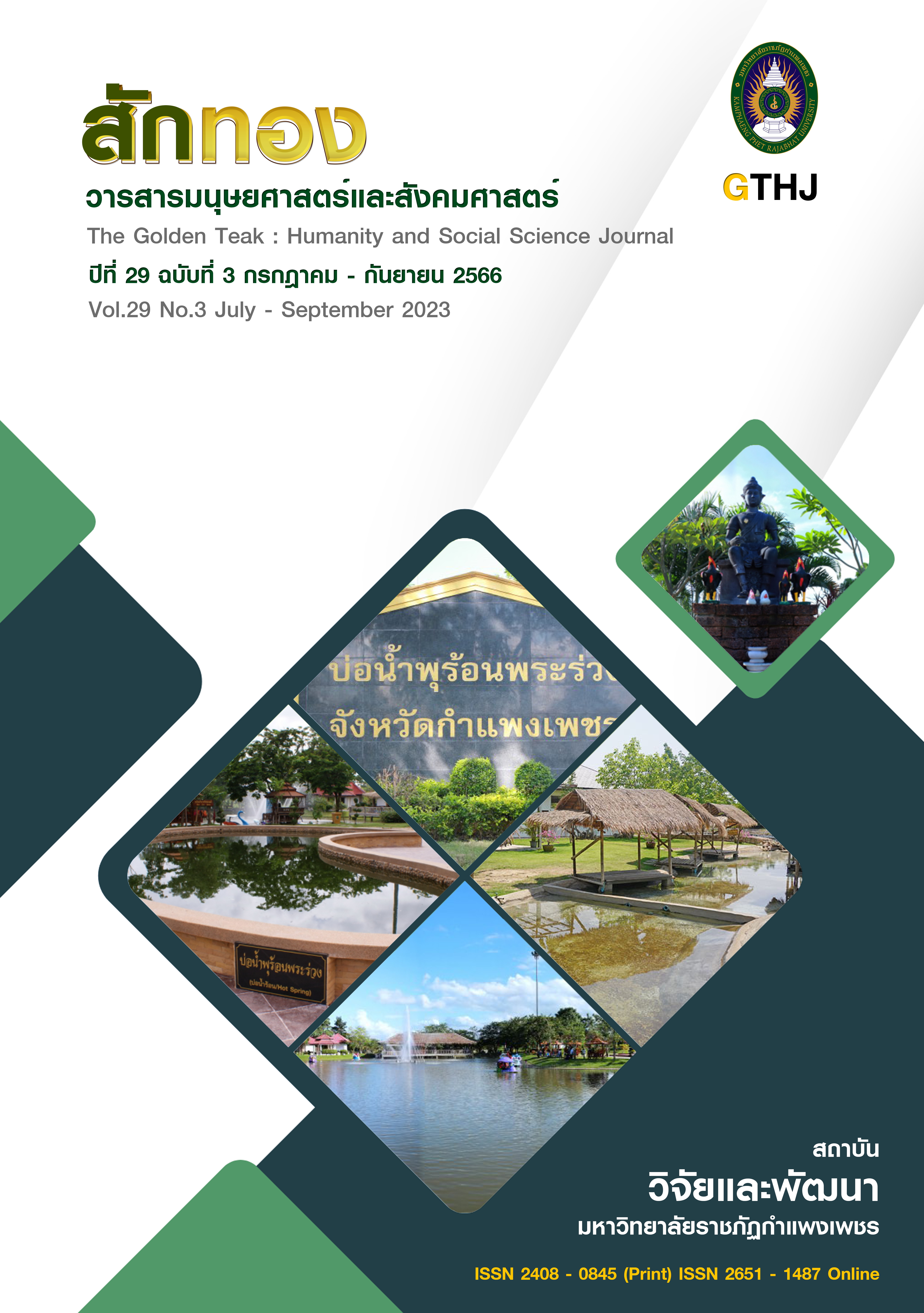การพัฒนารูปแบบการเรียนการสอนคณิตศาสตร์ตามแนวคิดห้องเรียนกลับด้านร่วมกับ การเรียนรู้แบบร่วมมือ เพื่อเสริมสร้างความสามารถในการคิดวิเคราะห์ ผลสัมฤทธิ์ทาง การเรียนและการกำกับตนเอง สำหรับนักศึกษาระดับประกาศนียบัตรวิชาชีพชั้นสูง
Main Article Content
บทคัดย่อ
การวิจัยครั้งนี้มีวัตถุประสงค์เพื่อ 1) พัฒนารูปแบบการเรียนการสอนคณิตศาสตร์ตามแนวคิดห้องเรียนกลับด้านร่วมกับการเรียนรู้แบบร่วมมือ เพื่อเสริมสร้างความสามารถในการคิดวิเคราะห์ ผลสัมฤทธิ์ทางการเรียนและการกำกับตนเอง สำหรับนักศึกษาระดับประกาศนียบัตรวิชาชีพชั้นสูง และ 2) ศึกษาผลการใช้รูปแบบการเรียนการสอนที่พัฒนาขึ้น กลุ่มตัวอย่างเป็นนักศึกษาระดับประกาศนียบัตรวิชาชีพชั้นสูง ภาคเรียนที่ 1 ปีการศึกษา 2564 จำนวนทั้งสิ้น 42 คน ได้มาจากการสุ่มอย่างง่ายวิธีจับสลากโดยใช้ห้องเรียนเป็นหน่วยการสุ่ม เครื่องมือที่ใช้ในการวิจัย ได้แก่ แบบทดสอบวัดความสามารถในการคิดวิเคราะห์, แบบทดสอบวัดผลสัมฤทธิ์ทางการเรียน, แบบสอบถามการกำกับตนเอง และแบบสอบถามความพึงพอใจ วิเคราะห์ข้อมูลโดยใช้ ร้อยละ, ค่าเฉลี่ย, ส่วนเบี่ยงเบนมาตรฐาน และการทดสอบค่าที ผลการวิจัยพบว่า รูปแบบการเรียนการสอนที่พัฒนาขึ้นชื่อว่า
SR2A Model มี 6 องค์ประกอบ คือ 1) ความเป็นมาและความสำคัญ 2) หลักการ 3) วัตถุประสงค์ (4) เนื้อหา
(5) กิจกรรมการเรียนรู้ ซึ่งมี 4 ขั้น คือ ขั้นที่ 1 ศึกษาสื่อ ขั้นที่ 2 รื้อฟื้นความรู้ ขั้นที่ 3 มุ่งสู่กิจกรรม
ขั้นที่ 4 นำไปประยุกต์ใช้ และ (6) การวัดและประเมินผล 2) ผลการใช้รูปแบบการเรียนการสอน ปรากฏดังนี้
(1) ความสามารถในการคิดวิเคราะห์, ผลสัมฤทธิ์ทางการเรียนและการกำกับตนเอง หลังเรียนสูงกว่าก่อนเรียน อย่างมีนัยสำคัญทางสถิติที่ระดับ .01 (2) ความสามารถในการคิดวิเคราะห์และผลสัมฤทธิ์ทางการเรียนหลังเรียนสูงกว่าเกณฑ์ร้อยละ 75 อย่างมีนัยสำคัญทางสถิติที่ระดับ .01 และ (3) ความพึงพอใจที่มีต่อการจัดการเรียนรู้โดยใช้รูปแบบ อยู่ในระดับมากที่สุด ( = 4.52, S.D. = 0.59)
Article Details

This work is licensed under a Creative Commons Attribution-NonCommercial-NoDerivatives 4.0 International License.
บทความที่ได้รับการตีพิมพ์เป็นลิขสิทธิ์ของวารสาร สักทอง : วารสารมนุษยศาสตร์และสังคมศาสตร์ สถาบันวิจัยและพัฒนา มหาวิทยาลับราชภัฏกำแพงเพชร
ข้อคิดเห็นใดๆ ที่ปรากฎในวารสารเป็นวรรณกรรมของผู้เขียนโดยเฉพาะ ซึ่งมหาวิทยาลัยราชภัฏกำแพงเพชรและบรรณาธิการไม่จำเป็นต้องเห็นด้วย
References
Acedo, M. (2013). 10 Pros and Cons of a Flipped Classroom. [Online]. Available : http://www.teach thought.com/uncategorized/10-pros-cons-flipped-classroom [2015, November 26].
Areeworawitkul, S. (2011). A study on Science Learning Achievement and Critical Thinking Abilities of Mathayomsuksa 1 Students through integrated Instruction and Cooperative Learning. MA. Thesis (Education), Srinakharinwirot University. [In Thai]
Bandura, A. (1968). Social foundations of thought and action: A social cognitive theory Englewood Cliffs. New Jersey : Prentice-Hell.
Bergmann, J. & Sams, A. (2012). Flip your classroom: Reach every student in every class everyday. Alexandria, VA : International Society for Technology in Education.
Bangpoopamorn, K. & Viriyanon, T. (2019). The Development of Learning and Teaching model on Flipped Classroom with Self-Regulation to Enhance Analytical Thinking for Undergraduate Students. Journal of Industrial Education King Mongkut’s North Bangkok, 10(2), 41-50. [In Thai]
Booraphapichitpai, P. (2015). The Flipped Classroom with Teaching in Thailand. Department of Educational Technology Faculty of Education Kasetsart University. [In Thai]
Fongjangwang, S. & Kongmanus, K. (2016). The Study of Components of Blended Instructional Model by Using Cooperative Learning in Basic Java Script Language Programming for Mathayom Suksa 3 Students. Academic journal Thai version, Veridian E-Journal, Silpakorn University, Humanities, Social Sciences and Arts, 9(3), 937-953. [In Thai]
Jeerungsuwan, N. (2015). Instructional Design and Assessment. (4 th ed.). Bangkok : Textbook Production Center King Mongkut's University of Technology North Bangkok. [In Thai]
Jitmitrapab, S. (2010). Changing the World of Learning in the 21st Century and the Development of “Professional Teacher”. In Sudaporn, L. (Editor). Learning to Change. Bangkok : Ministry of Education. [In Thai]
Johnson, D.W. & Johnson, R.T. (1994). Learning Together and Alone : Cooperative and Individuallistic Learning. (4 th ed.). Englewood Cliffs, New Jersey : Prentice Hall.
Kanjanapan, T. (2016). Effect of Flipped Classroom Approach on Biology Achievement, Self-Regulation and Instructional Satisfaction of the Grade 11 Students. MA. Thesis (Education) Songkhlanakarin University. [In Thai]
Laoriandee, W. (2011). Thinking Skills Instructional Models and Strategies. (8 th ed.). Nakhonprathom : Printing House of Silpakorn University. [In Thai]
Likert, R.A. (1932). A Technique for the Measurement of Attitudes. Archives of Psychology, 3(1), 42-48.
Makhanong, A. (2014). Mathematics for High School Teacher. Bangkok : Printing House of Chulalongkorn University. [In Thai]
Marlowe, C.A. (2012). The Effect of the Flipped Classroom on Student Achievement and Stress, Montana State University. [Online]. Available : http://scholarworks.montana.edu/xmlui/bitstream/heandle/1/1/1790/Marlower C0812.pdf? Sequence=1 [2015, November 26].
OECD. (2016). PISA 2015 Assessment and Analytical Framework : Science. Reading. Mathematics and Financial Literacy. Paris : OECD Publishing.
Office of the National Economic and Social Development Board. (2017). National Economic and Social Development Plan No.12 (2017-2021). Bangkok : Prime Minister’s Office. [In Thai]
Pahe, S. (2013). Flipped Classroom : A New Classroom in the 21st Century. In The Meeting of School Administrators under Phrae Educational Service Area Office 2. [Online]. Available : http://phd.mbuisc.ac.th/academic/ flipped%20classroom2.pdf [2015, November 26]. [In Thai]
Panich, V. (2012). Create Learning for Students in the 21st Century. Bangkok : SodSree-Salitwong Foundation. [In Thai]
Panich, V. (2013). Flipped Classroom From Teacher to Students. Bangkok : S-R printing-mask Product. [In Thai]
Pattamathumkul, J. (2014). To Know Flipped Classroom. [Online]. Available : https://piyanutphrasong025. wordpress.com/ [2021, March 12]. [In Thai]
Pianprakob, W. (2014). Achievement and Mathematical Process skills of Prathom suksa 5 students on Fraction Learning Through Management of Brain-Based Learning. MA. Thesis (Education), Rajabhat Chiangmai University. [In Thai]
Pimwan, C. (2021). The Teaching on Flipped Classroom with Knowledge (5E) to Enhance Analytical Thinking and Achievement on the Properties of Genetic Material and Mutations for Students in Grade 12. MA Thesis (Education), Mahasarakham University. [In Thai]
Poompoung, K. & Sittiwong, T. (2018). The Development of Learning and Teaching model on Flipped Classroom with Cooperative Learning for Students in Higher Education . Phitsanulok : Naresuan University. [In Thai]
Rakkiatwong, N. (2016). The Reform of Vocational in Thailand, Thailand Development Research Institute. [Online]. Available : https://tdri.or.th/2016/08/vocational-education-reform/ [2021, March 10] [In Thai]
Saa, A. (2016). Effect of Flipped Classroom on Learning Achievement, Analytical Thinking Skills and Instructional Satisfaction of Grade 11 Students. MA. Thesis (Education), Songkhlanakarin University. [In Thai]
Saenboonsong, S. (2017). The Development of Flipped Classroom Model Using Cloud Technology Approach on Academic Achievement in Computer Science for Teacher Couse for Undergraduate Students. Journal of Graduate Studies Valaya Alongkron Rajabhat University, 11(Special), 133-146. [In Thai]
The Institute for the Promotion of Teaching Science and Technology. (2012). Skills and Mathematical process. Bangkok : Q Media Co., Ltd.
Thongpun, N. (2013). Book Review: New future Skills: 21st Century Skills : Rethinking How Students Learn. Bangkok : Kasetsart University. [In Thai]

